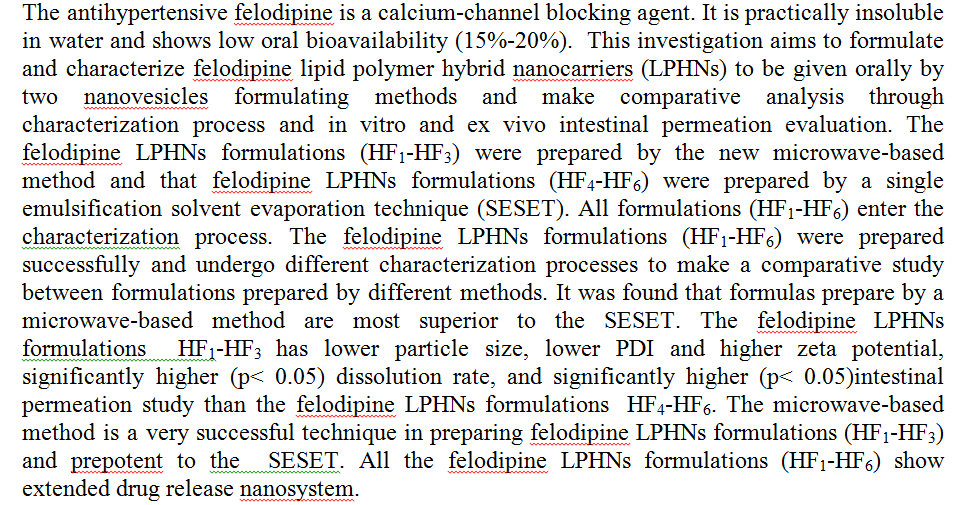Background: Dolutegravir sodium (DTG), used to treat HIV, faces challenges in delivering effective therapeutic concentrations to the brain due to the blood-brain barrier (BBB). Nanostructured lipid carriers (NLCs) combined with in situ gels present a promising strategy for enhancing brain drug delivery via the intranasal route. Objective: To compare brain pharmacokinetics of DTGs delivered via NLC-loaded in situ gel intranasal administration with the conventional intravenous (IV) drug solution. Methods: 80 Wistar rats, which were divided into three groups: two groups consisting of 39 animals each and a control group with 2 animals. Rats were administered with a dose of 1.0 mg/kg of DTGs IV, and DTGs NLC-loaded in situ gel were admin
... Show More (4)
(4)
 (2)
(2)
Patch in transdermal drug delivery(TDDS) used to overcome the hypodermic drawback, but these patch also have absorption limitation for hydrophilic and macromolecule like peptide and DNA. So that micronized projection have the ability for skin penetration developed named as microneedle. Microneedle drug delivery system is a novel drug delivery to overcome the limitation of TDDS like skin barrier restriction for large molecule. Microneedle patch can penetrate through skin subcutaneous into epidermis, avoiding nerve fiber and blood vessel contact. There are many type of microneedle patch like solid, polymer, hallow, hydrogel forming microneedle and dissolving microneedle with different method of microfabrication
 (4)
(4)
 (3)
(3)
 (2)
(2)
 (2)
(2)
Cilnidipine is a dihydropyridine class of calcium channel blockers, it is classified as a BCS class II drug, characterized by a low oral bioavailability of 13%. Consequently, the utilization of nanoparticle preparation is anticipated to enhance its bioavailability. The objective of the research is to integrate cilnidipine nanoparticles into oral films as a means of enhancing patient adherence. The optimal polymers for producing Cilnidipine films were PVA cold and or HPMC E5 at different concentrations using a casting technique with glycerol as a plasticizer. The Nano suspension-based preparation of Cilnidipine's oral film containing the combination of polymers exhibited a significant enhancement in vitro dissolution, with a percentage excee
... Show More (2)
(2)
 (3)
(3)
Commercially pure titanium (cpTi) is widely used as dental implant material although it was found that titanium exhibited high modulus of elasticity and the lower corrosion tendency in oral environment. Niobium(Nb) was chosen for this study as an alternative to cpTi implant material due to its bioinert behavior and good elastic modulus and moderate cost in addition to corrosion resistance. This study was done to evaluate the effect of biomimetic coating on the surface properties of the commercially pure titanium and niobium implants by in vitro and in vivo experiments. The in vitro study was involved etching the samples of each material in HCl then soaking in 10M NaOH aqueous solution. These samples were then immersed in a 5 times concent
... Show More (8)
(8)
 (4)
(4)
This paper focuses on developing a self-starting numerical approach that can be used for direct integration of higher-order initial value problems of Ordinary Differential Equations. The method is derived from power series approximation with the resulting equations discretized at the selected grid and off-grid points. The method is applied in a block-by-block approach as a numerical integrator of higher-order initial value problems. The basic properties of the block method are investigated to authenticate its performance and then implemented with some tested experiments to validate the accuracy and convergence of the method.
 (1)
(1)
 (28)
(28)
Background: Dental caries is one of the most significant problems in world health care. Restoring carious primary teeth is one of the major treatment goals for Children, and the light activated resin restoration materials like composite, resin-modified glass ionomer and polyacid-modified which was introduced in dentistry in 1970, widely used in clinical dentistry but its application increased dramatically in recent years because of its biocompatibility, color matching, good adhesive properties of its resemblance in physical and mechanical aspects to tooth. The aim of this study: To evaluate the microleakage of Polyacid-Modified Composite resin Compared to Flowable Hybrid Composite and Resin-Modified Glass ionomer cement. Materials and me
... Show More (6)
(6)
 (4)
(4)
Aim To develop a low-density polyethylene–hydroxyapatite (HA-PE) composite with properties tailored to function as a potential root canal filling material. Methodology Hydroxyapatite and polyethylene mixed with strontium oxide as a radiopacifier were extruded from a single screw extruder fitted with an appropriate die to form fibres. The composition of the composite was optimized with clinical handling and placement in the canal being the prime consideration. The fibres were characterized using infrared spectroscopy (FTIR), and their thermal properties determined using differential scanning calorimetry (DSC). The tensile strength and elastic modulus of the composite fibres and gutta-percha were compared, dry and after 1 month storage in
... Show More (6)
(6)
Medicinal plants contain bioactive substances that are highly bioavailable in extracts or pure molecules, making them promising for therapeutic applications and precursors for chemo-pharmaceutical semi-synthesis. Harpagophytum procumbens (Devil’s Claw) is widely recognized as one of the most potent therapeutic herbs. This study aimed to extract seeds from H. procumbens using two types of solvents and to assess both qualitative and quantitative aspects of the extracts. The two extracts were evaluated for antibacterial and anti-biofilm activities using agar well diffusion assays against four bacterial isolates and two yeast isolates. Qualitative analysis identified the presence of alkaloids, flavonoids, tannins, saponins, and terpen
... Show More (1)
(1)
 (1)
(1)

